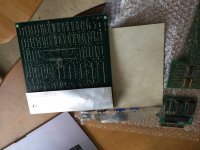tanaquil
Well-known member
I am embarking on a long project. I have been trying to take stock of my inventory, and it appears that I have an even dozen of Compact machines, ranging from 128K to a mystic Color Classic.
The goal is to get at least one model of each generation working. I am now able to declare the 128K working apart from the lack of a working internal disk drive (it does boot from an external disk drive), so that is step one.
Next I have two 512Ke machines and a Plus that are in parlous condition. (I have a working 512K with HyperDrive but frankly I am not touching that, if it ain't broke don't fix it.) Following them, I have two working SE machines, at least one SE of uncertain condition, a Classic in the process of being rebuilt, and a working SE/30 that I am trying to Frankenstein together with a non-working SE/30 (the working one has a messy case and minor analog board problems). And then there is the Color Classic, which was working last I remember, but is not starting now, and honestly I might have disconnected a bunch of stuff, I'm not sure. It will be last as I am working my way up the chain.
Which machines can be used to bench test other machines? What makes me nervous is that I am not willing to risk my working 128K and my working 512K, so I don't want to plug boards of unknown status into those machines. Am I right in thinking that it is no good trying to test (say) a 512Ke logic board with a known working SE analog board? I know there is a certain amount of continuity in the 128/512/Plus family and in the SE/SE-30/Classic family but maybe not between the two.
If the two groups cannot grok together I will see if I can rebuild a working Plus bench model and go from there. Advice welcome!
The goal is to get at least one model of each generation working. I am now able to declare the 128K working apart from the lack of a working internal disk drive (it does boot from an external disk drive), so that is step one.
Next I have two 512Ke machines and a Plus that are in parlous condition. (I have a working 512K with HyperDrive but frankly I am not touching that, if it ain't broke don't fix it.) Following them, I have two working SE machines, at least one SE of uncertain condition, a Classic in the process of being rebuilt, and a working SE/30 that I am trying to Frankenstein together with a non-working SE/30 (the working one has a messy case and minor analog board problems). And then there is the Color Classic, which was working last I remember, but is not starting now, and honestly I might have disconnected a bunch of stuff, I'm not sure. It will be last as I am working my way up the chain.
Which machines can be used to bench test other machines? What makes me nervous is that I am not willing to risk my working 128K and my working 512K, so I don't want to plug boards of unknown status into those machines. Am I right in thinking that it is no good trying to test (say) a 512Ke logic board with a known working SE analog board? I know there is a certain amount of continuity in the 128/512/Plus family and in the SE/SE-30/Classic family but maybe not between the two.
If the two groups cannot grok together I will see if I can rebuild a working Plus bench model and go from there. Advice welcome!
Last edited by a moderator:


